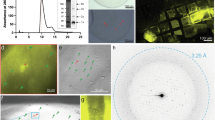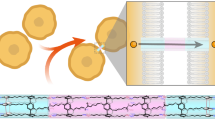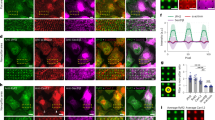Abstract
The cells in the mammalian lens are electrically1 and metabolically2 coupled with each other by a network of gap junctions. These are clusters of transmembrane channels by which the fibre cells situated deeper in the lens communicate through the epithelium with the aqueous humour, the source of nutrients for the lens. Hence gap junctions are important for lens transparency. The gap junction proteins in the mammalian lens have not yet been identified with certainty. A putative fibre gap junction protein of relative molecular mass 26,000 (26K)3 is not related to those from other tissues, such as the liver 28K junction component4,5. Another lens membrane protein with Mr 70K (MP70) has also been localized in the lens fibre gap junctions6,7. Here we demonstrate by a mi no-terminal sequence analysis that MP70 and its in vivo-processed form, MP38 (ref. 8), belong to a wider family of gap junction proteins9. With this new data on the lens, homologies between gap junction proteins now extend to organs derived from all three embryonal layers, endoderm (liver), mesoderm (heart) and ectoderm (lens).
This is a preview of subscription content, access via your institution
Access options
Subscribe to this journal
Receive 51 print issues and online access
$199.00 per year
only $3.90 per issue
Buy this article
- Purchase on SpringerLink
- Instant access to full article PDF
Prices may be subject to local taxes which are calculated during checkout
Similar content being viewed by others
References
Rae, J. L. & Mathias, R. T. in The Ocular Lens (ed. H. Maisel) 93–121 (Marcel Dekker, N.Y., 1985).
Goodenough, D. A., Dick, J. S. B. & Lyons, J. E. J. Cell Biol. 86, 576–589 (1980).
Revel, J. P., Yancey, S. B., Nicholson, B. & Hoh, J. Ciba Fdn Symp. 125, 108–127 (1986).
Gorin, M. B., Yancey, S. B., Cline, J., Revel, J. P. & Horwitz, J. Cell 39, 49–58 (1984).
Paul, D. J. Cell Biol. 103, 123–134 (1986).
Kistler, J., Kirkland, B. & Bullivant, S. J. Cell Biol. 101, 29–35 (1985).
Gruijters, W. T. M., Kistler, J., Bullivant, S. & Goodenough, D. A. J. Cell Biol. 104, 565–572 (1987).
Kistler, J. & Bullivant, S. Invest. Ophthalmol. Vis. Sci. 28, 1687–1692 (1987).
Nicholson, B. et al. Nature 329, 732–734 (1987).
Gruijters, W. T. M., Kistler, J. & Bullivant, S. J. Cell Sci. 88, 351–360 (1987).
Matsudaira, P. J. biol. Chem. 262, 10035–10038 (1987).
Beyer, E. C., Paul, D. L. & Goodenough, D. A. J. Cell Biol. 105 (in the press).
Dahl, G., Miller, T., Paul, D., Voellmy, R. & Werner, R. Science 236, 1290–1293 (1987).
Young, J. D. E., Cohn, Z. A. & Gilula, N. B. Cell 48, 733–743 (1987).
Laemmli, U. K. Nature 227, 680–685 (1970).
Nicholson, B., Gros, D., Kent, S., Hood, L. & Revel, J. P. J. biol. Chem. 260, 6514–6517 (1985).
Author information
Authors and Affiliations
Rights and permissions
About this article
Cite this article
Kistler, J., Christie, D. & Bullivant, S. Homologies between gap junction proteins in lens, heart and liver. Nature 331, 721–723 (1988). https://doi.org/10.1038/331721a0
Received:
Accepted:
Issue date:
DOI: https://doi.org/10.1038/331721a0
This article is cited by
-
Connexin-46/50 in a dynamic lipid environment resolved by CryoEM at 1.9 Å
Nature Communications (2020)
-
Cx43, ZO-1, alpha-catenin and beta-catenin in cataractous lens epithelial cells
Journal of Biosciences (2012)
-
Mefloquine Effects on the Lens Suggest Cooperative Gating of Gap Junction Channels
Journal of Membrane Biology (2006)
-
Mapping of new recessive cataract gene (itIr2) in the mouse
Mammalian Genome (1997)
-
Multiple connexin proteins in single intercellular channels: Connexin compatibility and functional consequences
Journal of Bioenergetics and Biomembranes (1996)



